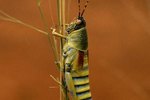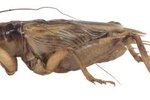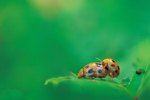
Grasshoppers are herbivores -- they get their nutrients exclusively from plants. As such, grasshoppers have a beneficial effect on the ecosystem. Their droppings, known as frass, provide essential nutrients for growing plants that nourish birds and other insects.
A Varied Diet
Many grasshopper species are general herbivores, meaning they eat a variety of plants, including grass, flowers and vegetables like sweet corn and lettuce. Grasshoppers feed mainly on leaves, but sometimes they also eat stems and seeds. Some species have adapted their dietary habits to the need to fend off predators, which include birds, lizards, spiders and rodents. The green bird (Schistocerca shoshone) grasshopper typically spends most of his day on a single plant, to lie low from predators and simultaneously take care of his dietary requirements. The horse lubber (Taeniopoda eques) and rainbow (Dactylotum variegatum) grasshoppers, however, take a more a la carte approach, moving constantly from plant to plant and “taking a nibble here and a nibble there,” the Desert Museum website notes.
Anomalies
Nature loves throwing up inter-species anomalies, and grasshoppers are no exception. The creosote bush grasshopper (Bootettix argentatus) is the only species of grasshopper that confines its diet to a single slant species -- the eponymous creosote bush found in arid desert regions. Olive green with pearly spots, the grasshopper mimics the shiny secretions on the bush’s leaves, camouflaging itself from predators.
Misconceptions
Due to their physical similarities and mutual membership of the orthopteroid insect group, grasshoppers are often confused with crickets. The latter, which are distinguished by their longer antenna, are omnivores, meaning they feed on a combination of plants and insects.
Grasshoppers in the Garden
As herbivores, grasshoppers should generally be welcome guests in your garden or shrubbery -- but a small number of species, including the twostripped and redlegged grasshopper species, can make meals of your shrubs, fruits and flowers during periods of overpopulation. Leaving grass borders unmowed can help deter grasshoppers from eating plants, because long grass gives them the food and shelter they need.
References
- The University of Arizona: Grasshopper Information
- University of Michigan: Grasshoppers Acrididae
- University of Nebraska: A Guide to Grasshopper Control in Yards and Gardens
- Northwestern University: What Is a Herbivore?
- Wild About Gardens: Grasshopper and Cricket
- Arizona-Sonora Desert Museum: Grasshoppers
Photo Credits
-
Jupiterimages/liquidlibrary/Getty Images
Writer Bio
Based in Belfast, Northern Ireland, Elizabeth Burns began writing professionally in 1988. She has worked as a feature writer for various Irish newspapers, including the "Irish News," "Belfast News Letter" and "Sunday Life." Burns has a Bachelor of Arts in English literature from the University of Ulster as well as a Master of Research in arts.




